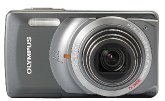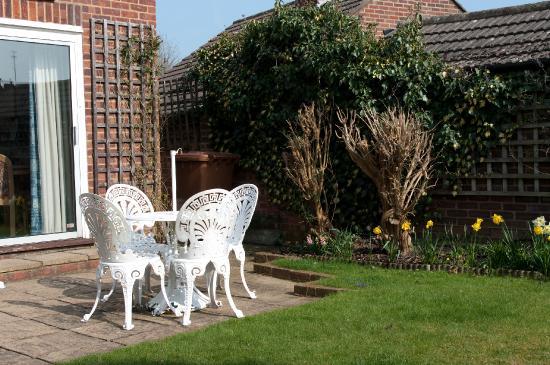Unfair Comparisons - Pentax K20D vs Olympus C-765
Okay, this is incredibly unfair, I'm going to show some of the more obvious differences between my old and new digital cameras. The compact is four years old, retailed for about £220 at the time, whilst my new purchase only came out last year and has a street price of about £600 for just the body on its own, add somewhat more for a lens or two.
So, ladies and gentlephones, in the blue corner, the 4 mega pixel Olympus Camedia C-765 UltraZoom, weighing in at 280g, and described by Practical Photography as having"Excellent image quality, with punchy colours, compact size and good value..." In the red corner, the 14.7 mega pixel Pentax K20D digital SLR, weighing in at a mere 800g, and about it Steve's Digicams states, "Bottom line - The K20D is a great camera for the photo-enthusiast - and the pro shooter alike."
Whilst good at contrast heavy shots, one weakness my old camera always had was with picking up the subtle details in things like skin tone, fur, bright and dark areas. For the time, it had a decent CCD sensor, but as I said in my previous update, I always found the pictures disappointing. One of the triggers for this usually came as a result of zooming in, the camera just wasn't capable of resolving the kind of detail its 4 mega pixels seem to claim it should be able to.
Check the following image of my dog, Minna, in the snow. All I've done to this image is correct the white balance, obviously there will be some loss of quality from JPEG compression but hopefully not enough to ruin the point. This is one of the best images I've got of her with that camera, it isn't a hard scene to handle exposure wise, most of it is very light, she is stationary and in focus. The light was good, as you can tell from the fact the camera used a 1/160th shutter speed and an ISO 64 equivalent sensitivity. I feel I should also mention the aperture here, for reference the F/stop was 3.2, although I'm not entirely convinced it is even a usable measurement on that compact.
Now look at one taken with the Pentax, this is a faster shutter speed as it's in sunlight, shot at 1/350th, however the ISO 100 difference almost makes the two similar in exposure values. F/stop was 8.0, which is obviously more light and a slightly wider depth of field, however the difference is staggering.
I've put together a quick comparison by blowing up sections of the fur from each image, this really shows the jump in resolving power. And note, that jump isn't just about mega pixels, these are both enlarged from 1:1 crops of the original images, and both from parts of the image clearly in focus.
What this all screams to me, is something I've suspect for many a year, that having X number of mega-pixels on your CCD doesn't necessarily mean it is actually capable of resolving that level of detail. Nerdy camera review sites, yes I appreciate the richness of that statement coming from me, often do test shots which contain converging black lines on a white background. These are a very clear way of showing at what point in the grand scheme of things the resolving power of a camera really sits at.
Which leads me onto the new found wonders of the RAW file format. Put simply, for those that do not know, if your camera can shoot in RAW you get to do your own digital developing. This isn't that bit of colour correction, red-eye reduction and sharpening you might do on a JPEG file, oh no, this is far more like the modern day equivalent of sitting in a darkened room carefully deciding how dark, light, bright, contrasty, subtle, etc, you want your images to look, only a heck of a lot faster.
Digital SLRs have sensors that are often able to resolve 12 bits (talking binary here!) of colour information per red, green and blue channel. Pretty much all compact cameras I've seen do the usual 8 bits, which just like the resulting JPEGs they create, giving you 256 levels each of RGB info. Sounds like plenty? Yes it is, if the image you recorded is perfect in every way.
Only it isn't always like that. Film has always been quite forgiving, like all forms of recording it has a minimum level of data it can record, and a maximum. The minimum in this instance is of course white, and the maximum is black. Even if you under or over expose an image, providing the detail you are interested in falls between those two boundaries, you can usually get the final print you want by fixing things in the development process.
You can do this because the number of steps between black and white that film records, is far more than 256. I've not read a definitive measurement as to what it exactly is, but for practical purposes it is at least 4096, and probably more because it is after all an analogue medium. Providing the exposure wasn't way off, the details are there, you just have to get at them. Home developing was often the best way to do this, though the chemicals involved and shear expense has always put them out of my own personal reach.
Remember that mention of 12 bit sensors on digital SLRs? That equates to 4096 levels, and cameras that support RAW files are able to take the raw data from those sensors and shove them straight into a (very big) file. The actual exact format of that file is usually different from one manufacturer to the next, although Adobe decided to create a standardised version called DNG or Digital Negative that many support.
Pentax's own format is loosely based on TIFF, and thanks to compression (loss-less of course) manages to produce files not a huge amount larger than the highest quality JPEGs. The former being about 11 to 15MB, with the latter usually arriving at just under 9MB.
All of that leads me on to my final example for the week, another comparison between old and new cameras. I've re-sized the Pentax image down to around the same as the other for this one, just to make it more obvious. As you can see both shots are of the same scene, which is a sunny day and includes both light and dark areas. Using a straight comparison, the Olympus (top) already shows fringing on any areas of detail, probably introduced by sharpening the image in software.
Other differences immediately obvious include far less rich colours, glare around bright areas and some halo effects. Also if you look at the dark areas on both you'll see a large amount of noise on the Olympus originated picture.
But back to the main point, if you then take the two images which have roughly taken the same sort of exposure, and you ramp back the exposure on each in software, they clearly show that the Olympus (again the top of the two) and it's JPEG format has no detail on the highlights of the garden chairs, where as the Pentax has captured quite simply oodles of it. I've cropped both for another comparison.
There is something about the build up to this genuine video, which puts me in mind of the very few teachers at my school that demanded not just the respect of the classes they took, but in some cases admiration for their ability or knowledge. Check out this guy, who was a former World Freehand Circle Drawing Champion, and no before even seeing this I didn't know this existed as a competition.
Plus, no column entry by me would be complete without some nostalgia, enter footage of Battle Chess. This was a game I really wanted at the time on my Amiga all those years ago, though looking back quite why I don't know. The concept was simple, take the game of chess, put an okay AI engine into it, then animate all the chess pieces so when you got to take something, it got taken in style.
So, ladies and gentlephones, in the blue corner, the 4 mega pixel Olympus Camedia C-765 UltraZoom, weighing in at 280g, and described by Practical Photography as having"Excellent image quality, with punchy colours, compact size and good value..." In the red corner, the 14.7 mega pixel Pentax K20D digital SLR, weighing in at a mere 800g, and about it Steve's Digicams states, "Bottom line - The K20D is a great camera for the photo-enthusiast - and the pro shooter alike."
Whilst good at contrast heavy shots, one weakness my old camera always had was with picking up the subtle details in things like skin tone, fur, bright and dark areas. For the time, it had a decent CCD sensor, but as I said in my previous update, I always found the pictures disappointing. One of the triggers for this usually came as a result of zooming in, the camera just wasn't capable of resolving the kind of detail its 4 mega pixels seem to claim it should be able to.
Check the following image of my dog, Minna, in the snow. All I've done to this image is correct the white balance, obviously there will be some loss of quality from JPEG compression but hopefully not enough to ruin the point. This is one of the best images I've got of her with that camera, it isn't a hard scene to handle exposure wise, most of it is very light, she is stationary and in focus. The light was good, as you can tell from the fact the camera used a 1/160th shutter speed and an ISO 64 equivalent sensitivity. I feel I should also mention the aperture here, for reference the F/stop was 3.2, although I'm not entirely convinced it is even a usable measurement on that compact.
Now look at one taken with the Pentax, this is a faster shutter speed as it's in sunlight, shot at 1/350th, however the ISO 100 difference almost makes the two similar in exposure values. F/stop was 8.0, which is obviously more light and a slightly wider depth of field, however the difference is staggering.
I've put together a quick comparison by blowing up sections of the fur from each image, this really shows the jump in resolving power. And note, that jump isn't just about mega pixels, these are both enlarged from 1:1 crops of the original images, and both from parts of the image clearly in focus.
What this all screams to me, is something I've suspect for many a year, that having X number of mega-pixels on your CCD doesn't necessarily mean it is actually capable of resolving that level of detail. Nerdy camera review sites, yes I appreciate the richness of that statement coming from me, often do test shots which contain converging black lines on a white background. These are a very clear way of showing at what point in the grand scheme of things the resolving power of a camera really sits at.
RAW vs JPEG
Which leads me onto the new found wonders of the RAW file format. Put simply, for those that do not know, if your camera can shoot in RAW you get to do your own digital developing. This isn't that bit of colour correction, red-eye reduction and sharpening you might do on a JPEG file, oh no, this is far more like the modern day equivalent of sitting in a darkened room carefully deciding how dark, light, bright, contrasty, subtle, etc, you want your images to look, only a heck of a lot faster.
Digital SLRs have sensors that are often able to resolve 12 bits (talking binary here!) of colour information per red, green and blue channel. Pretty much all compact cameras I've seen do the usual 8 bits, which just like the resulting JPEGs they create, giving you 256 levels each of RGB info. Sounds like plenty? Yes it is, if the image you recorded is perfect in every way.
Only it isn't always like that. Film has always been quite forgiving, like all forms of recording it has a minimum level of data it can record, and a maximum. The minimum in this instance is of course white, and the maximum is black. Even if you under or over expose an image, providing the detail you are interested in falls between those two boundaries, you can usually get the final print you want by fixing things in the development process.
You can do this because the number of steps between black and white that film records, is far more than 256. I've not read a definitive measurement as to what it exactly is, but for practical purposes it is at least 4096, and probably more because it is after all an analogue medium. Providing the exposure wasn't way off, the details are there, you just have to get at them. Home developing was often the best way to do this, though the chemicals involved and shear expense has always put them out of my own personal reach.
Remember that mention of 12 bit sensors on digital SLRs? That equates to 4096 levels, and cameras that support RAW files are able to take the raw data from those sensors and shove them straight into a (very big) file. The actual exact format of that file is usually different from one manufacturer to the next, although Adobe decided to create a standardised version called DNG or Digital Negative that many support.
Pentax's own format is loosely based on TIFF, and thanks to compression (loss-less of course) manages to produce files not a huge amount larger than the highest quality JPEGs. The former being about 11 to 15MB, with the latter usually arriving at just under 9MB.
All of that leads me on to my final example for the week, another comparison between old and new cameras. I've re-sized the Pentax image down to around the same as the other for this one, just to make it more obvious. As you can see both shots are of the same scene, which is a sunny day and includes both light and dark areas. Using a straight comparison, the Olympus (top) already shows fringing on any areas of detail, probably introduced by sharpening the image in software.
Other differences immediately obvious include far less rich colours, glare around bright areas and some halo effects. Also if you look at the dark areas on both you'll see a large amount of noise on the Olympus originated picture.
But back to the main point, if you then take the two images which have roughly taken the same sort of exposure, and you ramp back the exposure on each in software, they clearly show that the Olympus (again the top of the two) and it's JPEG format has no detail on the highlights of the garden chairs, where as the Pentax has captured quite simply oodles of it. I've cropped both for another comparison.
The Video Bit
There is something about the build up to this genuine video, which puts me in mind of the very few teachers at my school that demanded not just the respect of the classes they took, but in some cases admiration for their ability or knowledge. Check out this guy, who was a former World Freehand Circle Drawing Champion, and no before even seeing this I didn't know this existed as a competition.
Plus, no column entry by me would be complete without some nostalgia, enter footage of Battle Chess. This was a game I really wanted at the time on my Amiga all those years ago, though looking back quite why I don't know. The concept was simple, take the game of chess, put an okay AI engine into it, then animate all the chess pieces so when you got to take something, it got taken in style.





































Your Opinions and Comments
Be the first to post a comment!